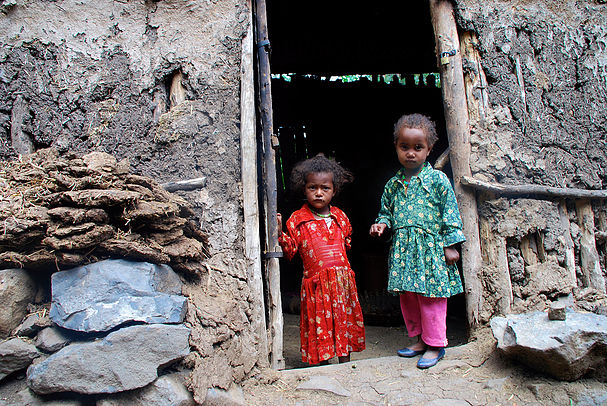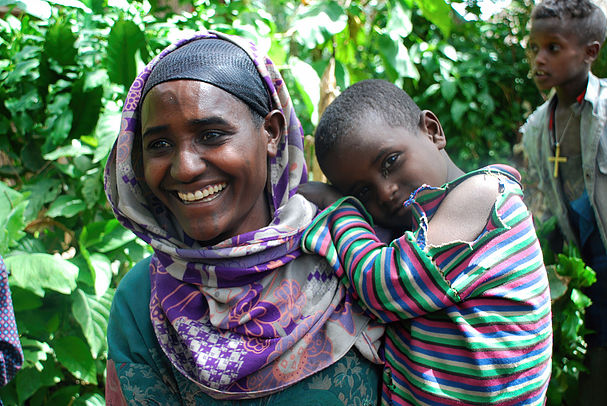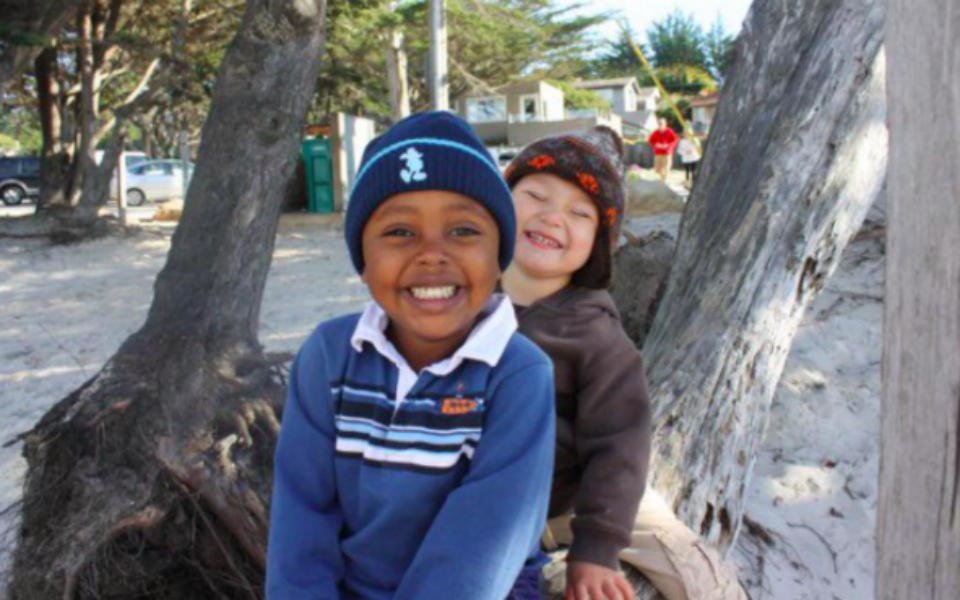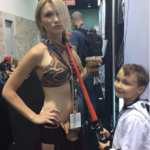After two days on a plane and two days in the car, we finally made it to the rural village of Bichena, Ethiopia. I had come with a team from Milkmakers, a brand that is famous for lactation cookies and a hilariously badass logo. But we weren’t there to swap funny stories about breastfeeding advocacy and support. We had come together to work with Clinic at a Time, a 501(c)(3) nonprofit that focuses on building and expanding health clinics in rural Ethiopia. We were invited to observe the state of the current maternal health suite and be there when they broke ground on the expansion.
I wasn’t sure why an expansion was so exciting to Mulu, founder of Clinic at a Time, until that first visit to the clinic. We had been there for less than five minutes when a barefoot woman came staggering into the courtyard, blood trailing behind her.
“Was this active labor?” I wondered? Oh no, it was not. Moments later, we were alerted that this woman had given birth back in her hut, but the placenta was never delivered. Several things had gone wrong, and now this mother’s life was at tremendous risk.
Due to understaffing and lack of resources, the mother-to-be was not made aware that she could have lived at the clinic during her final month of pregnancy. The clinic will feed and house the mother and her small children to make sure they are in close proximity during this critical month of gestation. This mother was also not aware that an ambulance could have been called to get her to the clinic quickly. She believed that after the baby was born, she couldn’t call an ambulance anymore. This really stuck with me: She didn’t believe her life was important enough for an ambulance after her child was born.
We discovered the mother had made it to the clinic via wooden bed (it’s basically a wooden stretcher used to carry the sick and the dead) and a hailed bajaj (a small three-wheeled vehicle). She could have hemorrhaged in minutes due to her condition, but the mother managed to make it to the clinic several HOURS after delivery, although she was profusely bleeding.
Embedded content: https://www.instagram.com/p/BIdQMYMhNUN/?taken-by=jgrumet
RELATED: My Near-Misses With Terrorist Attacks Aren't the Point
The clinic midwife helped the mother deliver the placenta successfully, and pitocin was administered to stop the bleeding. I asked about a blood transfusion, but Mulu told me that even if she had needed one, it wouldn't have been available. There wouldn't have been anything they could do.
I couldn’t stop thinking about all of this region's women who have needlessly died due to pregnancy complications.
To put this into perspective, the United States has the highest rate of maternal death in the Western world, with about 18.5 women dying per 100,000 births here. Ethiopia has 353 maternal deaths per 100,000 live births—a number that includes the much more developed areas of the country where the regional rate is lower. Rural areas like Bichena can expect to have a number much higher than the national average.
I joked that if this baby was a girl, I think our presence here was a sign to breastfeed her for three years like her brothers.
When the mother was stabilized, we were able to meet and talk to her. She had delivered at home, as she had with all of her other children. This time, though, the placenta didn’t come out. The women attending her birth began to panic, and so did her children. In the rush to try to save her life, she hadn't even found out whether she'd given birth to a boy or a girl. The chaos of her children and husband screaming, and the village trying to get this woman to the hospital without an ambulance, was too much chaos to even enjoy the new life that had she had just brought into the world.
There were signs up all around the clinic stating that breastfeeding needs to be initiated within the first hour of birth. Both the mother and her husband were at the clinic, so I asked where the baby was.
The little one was being cared for by the women in her village.
I asked about how she feeds her babies, and she said that the village has no bottles or formula. It’s breastfeeding or nothing.
I asked if cross-nursing was available to her newborn (this is where a lactating woman will feed a child who is not biologically or legally hers). She told me that it isn’t practiced in her village and that you make your own milk. Mothers in her village breastfeed their boys for three years and their girls for two years, because they don’t want the girls to become aggressive. She then said that, in the rare cases where women don’t produce enough milk, the kids are just very small and thin.
I was cringing listening to this, and I started getting very worried for that baby, since it had been several hours since his or her birth. Because there had been a miscommunication during her care, our team opted to intervene. I asked the mother and father if we could go collect the child and bring the baby back to the clinic so the mother could initiate the first feed.
Unsurprisingly, she said yes and seemed very appreciative. I joked that if this baby was a girl, I think our presence here was a sign to breastfeed her for three years like her brothers. The mother giggled in her hospital bed and we left.
Embedded content: https://www.instagram.com/p/BJBUcRsBaBr/?taken-by=jgrumet
Soon after this, I walked outside to find the woman who had accompanied the bleeding mother and her husband. She was sitting outside breastfeeding her toddler. The husband said something to her, and she smiled and grabbed my hand. We jumped into the car together and drove about 40 minutes out into a more rural area.
We had come to Ethiopia during the rainy season. This day was hot and muggy, and thunder clouds rumbled over us. Still, it was dry. Our driver pulled up as far as he could, but the terrain got too rocky, so he stopped and let us out. I was on my own, following someone who spoke no English (and I speak a laughably poor amount of Amharic) into a remote village thousands of miles from home.
I was cringing listening to this, and I started getting very worried for that baby, since it had been several hours since his or her birth.
I looked around at the intensity of my surroundings. The agricultural community I was visiting was using farming techniques and tools that have not changed for thousands of years. The ox and plow I saw working with its master across the field would be identical to one I would see if I were living during biblical times.
RELATED: They Said Breastfeeding On the Cover of Time Would Ruin My Son
I had to keep looking down at the path. I stepped carefully over volcanic rock, which, mixed with fresh patches of grass, created a natural, albeit unsteady, path into the village. The farming tools already blew my mind, but it was the historic significance of that volcanic-rich soil in this remote area that really pushed it over the top. It was so clear to me in this setting as to why life would flourish here. Ethiopia has been called the cradle of civilization, and some people even think the Garden of Eden was located in Ethiopia (or in the horn of Africa).
So a place where life started, and has endured for thousands of years, was a stark contrast to the near-death I had seen from the mother in the clinic and the reason I was walking this path on that day.
Bichena doesn’t get many Western visitors, so the novelty of my presence was very apparent. I was suddenly surrounded by every child from the village. They all looked like I imagine kids should look: Safe to play freely in their village, not wasting water (and also without running water in their homes), so they were dusty and naturally messy from being outdoors. I noticed their tattoos and their jewelry, both Christian and Muslim in equal proportions and everyone living side-by-side in the village.
The woman who had grabbed my hand and led me to the car again grabbed my hand, this time leading me inside a large hut.

There were no windows but tall ceilings. It was midday, but extremely dark inside. I heard whispers and, as soon as my eyes adjusted, I saw about seven women, both Christian and Muslim, standing in the main room. They didn’t speak English, but I was able to at least ask where the baby was. They showed me the newborn, lying in the only bed in the house, under the protection of a mosquito net that had been grandly draped from the top of the high ceiling to the floor.
I asked the woman standing closest to me if it was a boy or a girl.
“Mammitu,” she said, a little girl.
At this point the new father was frantically looking for something in the storage part of the home. I was confused and ready to get this baby back to her mother, but he insisted. The storage section of the hut was mostly bulky items used for storing injera bread or other furniture created from wood and hyde. In the mix of all the bulk, he pulled out five different pieces of paper—the only paper in the storage area. He handed me one of the papers as if it were of utmost importance.
It was a vaccination card, written in English. It seemed that either the mother or one of their children had, at some point, been vaccinated for meningitis.
I was thinking about my own loss of these early moments with my two children, but how happy I was that we were actively trying to make sure that this mother's experience would be different than mine.
I tried to tell him I didn’t need the card, but it wasn’t any use, our language barrier was too great for any sort of worthwhile communication. I looked at it, thanked him in Amharic and bowed my head so that he would take it back. I sometimes think about that interaction since i’ve been home. How one vaccine made him feel protected, while only dozens make us in the West feel that way. (I also realized how inaccessible vaccines are in this region, and that one was worth so much. How easily we dismiss the availability of them in our part of the world.)
One of the women wrapped the baby up in cloth, including her face. They handed me the baby, and I realized that, only a few hours old, she was the youngest child I had ever held in my entire life. Due to my own severe health complications during pregnancy, I wasn’t able to hold my biological son until he was three days old and I was healthy enough to visit him in the NICU. My oldest son was adopted from Ethiopia at almost 4. But now, amongst strangers in an underdeveloped part of the world, I had been given the honor of holding this newborn for the ride to the clinic.
The woman who was initially holding the child sat next to me in the small SUV, while the father of the baby sat in the back. We don't typically cover baby’s faces with blankets in the states, so my initial instinct was to remove the cloth over her. I pulled back the (very breathable) cotton blanket to reveal the perfection—and the beginning of a personality and identity of this new life—cradled in my arms. My awe of this tiny human was quickly squashed when the woman sitting next to me covered the baby’s face back up. She did it kindly and with a smile. But in this region, they don’t want the baby exposed to bugs, and they also believe that the baby should be in dark spaces to mimic the womb. With no seatbelt or carseat within hundreds of miles, there we were as a group, trying to keep this baby safe in various ways.

RELATED: Why Syrian Men Caring For Kids Is So Surprising To Aid Workers
As we drove on, the woman must have realized I was emotional about something. I was thinking about my own loss of these early moments with my two children, but how happy I was that we were actively trying to make sure that this mother’s experience would be different than mine. The woman grabbed my arms to on both sides of where I was cradling the baby, cradling me. We drove the entire way like this. Her maternal protection over the baby, and then me, is a feeling I will never forget.
We had finally arrived back at the clinic, where the mother was quickly informed she had a baby girl. The baby instantly took to the breast, and the mother stated matter-of-factly, “She’ll be breastfed until she’s 3.”
In that moment, understanding the complexity of patriarchy, the fragility of life and the delicate nature of cross-cultural interactions, I was extremely satisfied with the choices our team made that day.

Photographs by: Jamie Grumet




